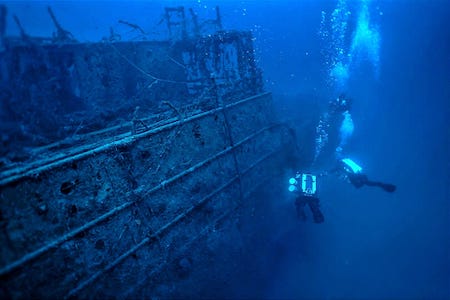Hypoxic Trimix
For those with Hypoxic Trimix certification and considerable experience, we have some really special dives for you.
On our Hypoxic Trimix Dive Trip, we’ll be diving up to 75m, or up to 90m if you have the designated depth on your certification and serious experience. One good, long dive per day, our possible dives include:
SS MONROSA – South of Arsida islet – An Italian steam cargo ship, she went down in 1941 having been struck by the British submarine HMS Triumph on her way to Piraeus. Accompanied by some defender ships, a short battle ensued, but the submarine managed to dive and get away. She is large and lies between 75-90m.
SS PATRIS (not to be confused with PSS PATRIS) Patroklos Island. The carrier Patris , built in England in 1902, was travelling from Piraeus to Naxos in June 1927 and collided with the carrier Moschanthi Togia sinking within 2 minutes. Eleven lives were lost. She lies at depths between 67 and 72m.
SS ROSA VLASI – between Makronissos and Lavrio “Rosa Vlassi” loaded with a cargo of 2900 tones of mixed ferro-silicon, left Piraeus on 24 December 1959. About a mile and a half south of Sounio, she started to incline at an angle of 40-45 degrees. The Captain broadcast a Mayday and the crew prepared for the worst. Captain lost control of the helm and the ship overturned and sank.
German submarine U-133 – NW Saronic Gulf German submarine U-133 was a Type VIIC U-boat built for Nazi Germany’s Kriegsmarine for service during World War II. She sank with all hands lost after striking a mine off Aegina island Greece on 14 March 1942.
SS BURDIGALA (flagship dive)- Kea Strait – Built as Ocean Liner S/S Kaiser Friedrich in 1897-1898 she was requisitioned by the French Government and used as transporter for the Dardanelle Campaign in 1914. On 14.11.1916 she struck a mine and sank off the island of Kea. A week later the HMHS Britannic sank two nautical miles far from her for the same reason. The mines were deployed by the German submarine U 73 in October 1916. The S/S Burdigala is the second largest wreck in the Greek Seas.
JUNKERS 52 – Kea Strait – Produced by the Junkers Company in Germany for the Luftwaffe, she took part in “Operation Mercury” (May 1941, Crete) and “Operation Barbarossa” (June 1941, Russia). She belonged to the First Group of the Transport Wing No. 4 (I/TG 4) of the Luftwaffe. On 6.9.1943 she was lost after ditching in the northwest sea of Kea, due to fuel supply problems. The Ju 52 of Kea is one of the best preserved Junkers 52 in the Greek Seas.

